72避碰规则
- 格式:doc
- 大小:45.00 KB
- 文档页数:17

《国际海上避碰规则》培训讲义对于《1972年国际海上避碰规则》大家都不陌生,而且都有不同程度的理解和解释,在实际工作中也都切实地运用了多年,从理论到实践都有了比较深刻的掌握。
由于近来中远发生了多起因在船舶航行时发生了碰撞事故,并且还有导致了船舶的沉没,,象大家都知道的中散的“富山海”,(今年的5月31日,“富山海”轮从拉脱维亚的文特斯推尔港装满化肥,启程回国。
在波罗的海航行,与一艘在塞浦路斯注册的波兰籍“格丁尼亚”号集装箱相撞。
当时中方船员曾鸣笛示警,但该集装箱货轮并未减速或改变航道,而是径自撞向富轮。
事故发生后,富山海轮左舷一、二舱破裂,水流急涌而入,由于船头大量进水,船舵失灵,经过1个小时的努力,多方营救,抢救无效,富山海轮沉没在丹麦海域的博恩霍尔姆岛附近,船上的27名船员全部获救,无人伤亡。
据讲,当时的天气不错,能见度也比较好。
)鉴于诸多的原因,我们举办了这次的讨论。
今天我不是来讲课,是借这样一个机会,大家对《1972年国际海上避碰规则》再进行一次复习,针对目前海运方面发生的多起海损事故的原因,来加以分析,从中找出我们在执行和实施〈规则〉中还存在的问题和雾区,把我们公司的安全工作切实地落实到实处,夯实基础,真正地为航运做好保驾护航。
这次我们着重讨论第二章的驾驶和航行规则和第三章的号灯和号型。
一、《规则》的简要介绍第二章驾驶和航行规则本章共包括十六条规则(第四条至第十九条),按环境条件划分:1.在任何能见度情况下为七条(第四条至第十条的)2.在互件中八条(第十一条至第十八条)3.在能见度不良情况下一条(第十九条)第三章号灯和号型本章共包括十六条规则(第二十条至第三十一条)二、讲义任何能见度的情况下的行动规则第五条:了望 LOOK-OUT“每一船在任何时候都应使用视觉、听觉以及适合当时环境和情况的一切有效手段保持正规了望,以便对局面和碰撞危险做出充分的估计。
”了望的重要性:强调确保海上航行安全首要因素就是保持正规的了望,诸多次的海上碰撞事故统计的结果表明,没有能保持正规的了望是导致碰撞事故发生的重要原因/主要原因。
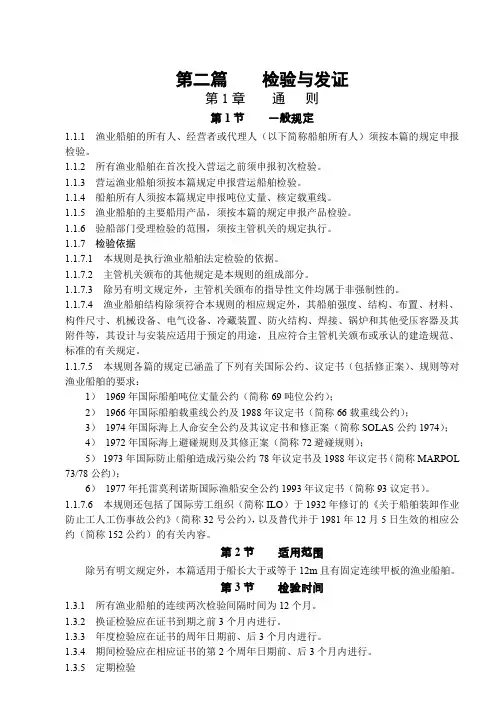
第二篇检验与发证第1章通则第1节一般规定1.1.1 渔业船舶的所有人、经营者或代理人(以下简称船舶所有人)须按本篇的规定申报检验。
1.1.2 所有渔业船舶在首次投入营运之前须申报初次检验。
1.1.3 营运渔业船舶须按本篇规定申报营运船舶检验。
1.1.4 船舶所有人须按本篇规定申报吨位丈量、核定载重线。
1.1.5 渔业船舶的主要船用产品,须按本篇的规定申报产品检验。
1.1.6 验船部门受理检验的范围,须按主管机关的规定执行。
1.1.7 检验依据1.1.7.1 本规则是执行渔业船舶法定检验的依据。
1.1.7.2 主管机关颁布的其他规定是本规则的组成部分。
1.1.7.3 除另有明文规定外,主管机关颁布的指导性文件均属于非强制性的。
1.1.7.4 渔业船舶结构除须符合本规则的相应规定外,其船舶强度、结构、布置、材料、构件尺寸、机械设备、电气设备、冷藏装置、防火结构、焊接、锅炉和其他受压容器及其附件等,其设计与安装应适用于预定的用途,且应符合主管机关颁布或承认的建造规范、标准的有关规定。
1.1.7.5 本规则各篇的规定已涵盖了下列有关国际公约、议定书(包括修正案)、规则等对渔业船舶的要求:1)1969年国际船舶吨位丈量公约(简称69吨位公约);2)1966年国际船舶载重线公约及1988年议定书(简称66载重线公约);3)1974年国际海上人命安全公约及其议定书和修正案(简称SOLAS公约1974);4)1972年国际海上避碰规则及其修正案(简称72避碰规则);5)1973年国际防止船舶造成污染公约78年议定书及1988年议定书(简称MARPOL 73/78公约);6)1977年托雷莫利诺斯国际渔船安全公约1993年议定书(简称93议定书)。
1.1.7.6 本规则还包括了国际劳工组织(简称ILO)于1932年修订的《关于船舶装卸作业防止工人工伤事故公约》(简称32号公约),以及替代并于1981年12月5日生效的相应公约(简称152公约)的有关内容。
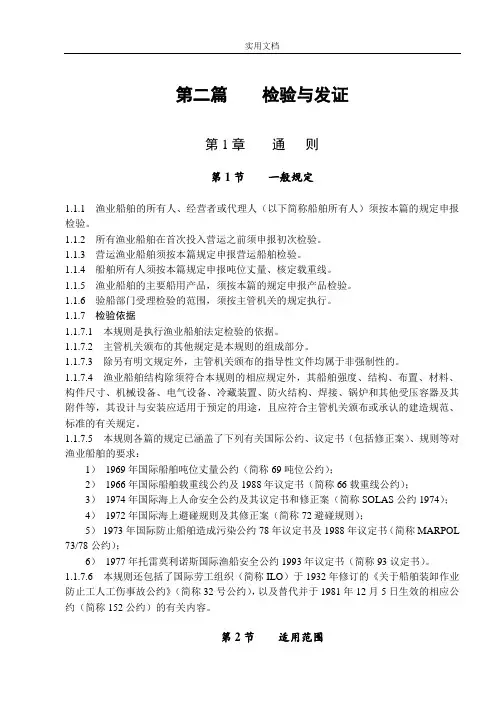
第二篇检验与发证第1章通则第1节一般规定1.1.1 渔业船舶的所有人、经营者或代理人(以下简称船舶所有人)须按本篇的规定申报检验。
1.1.2 所有渔业船舶在首次投入营运之前须申报初次检验。
1.1.3 营运渔业船舶须按本篇规定申报营运船舶检验。
1.1.4 船舶所有人须按本篇规定申报吨位丈量、核定载重线。
1.1.5 渔业船舶的主要船用产品,须按本篇的规定申报产品检验。
1.1.6 验船部门受理检验的范围,须按主管机关的规定执行。
1.1.7 检验依据1.1.7.1 本规则是执行渔业船舶法定检验的依据。
1.1.7.2 主管机关颁布的其他规定是本规则的组成部分。
1.1.7.3 除另有明文规定外,主管机关颁布的指导性文件均属于非强制性的。
1.1.7.4 渔业船舶结构除须符合本规则的相应规定外,其船舶强度、结构、布置、材料、构件尺寸、机械设备、电气设备、冷藏装置、防火结构、焊接、锅炉和其他受压容器及其附件等,其设计与安装应适用于预定的用途,且应符合主管机关颁布或承认的建造规范、标准的有关规定。
1.1.7.5 本规则各篇的规定已涵盖了下列有关国际公约、议定书(包括修正案)、规则等对渔业船舶的要求:1)1969年国际船舶吨位丈量公约(简称69吨位公约);2)1966年国际船舶载重线公约及1988年议定书(简称66载重线公约);3)1974年国际海上人命安全公约及其议定书和修正案(简称SOLAS公约1974);4)1972年国际海上避碰规则及其修正案(简称72避碰规则);5)1973年国际防止船舶造成污染公约78年议定书及1988年议定书(简称MARPOL 73/78公约);6)1977年托雷莫利诺斯国际渔船安全公约1993年议定书(简称93议定书)。
1.1.7.6 本规则还包括了国际劳工组织(简称ILO)于1932年修订的《关于船舶装卸作业防止工人工伤事故公约》(简称32号公约),以及替代并于1981年12月5日生效的相应公约(简称152公约)的有关内容。
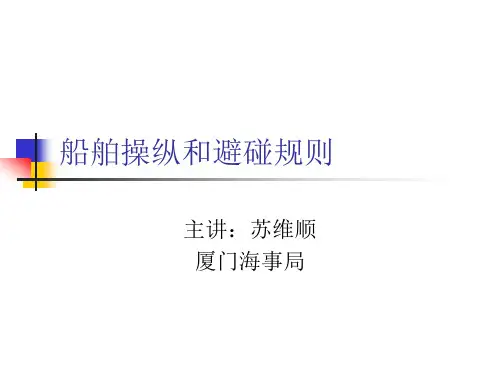
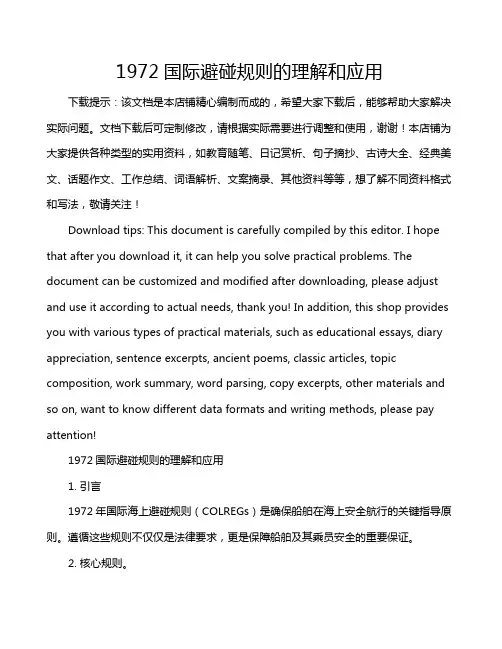
1972国际避碰规则的理解和应用下载提示:该文档是本店铺精心编制而成的,希望大家下载后,能够帮助大家解决实际问题。
文档下载后可定制修改,请根据实际需要进行调整和使用,谢谢!本店铺为大家提供各种类型的实用资料,如教育随笔、日记赏析、句子摘抄、古诗大全、经典美文、话题作文、工作总结、词语解析、文案摘录、其他资料等等,想了解不同资料格式和写法,敬请关注!Download tips: This document is carefully compiled by this editor. I hope that after you download it, it can help you solve practical problems. The document can be customized and modified after downloading, please adjust and use it according to actual needs, thank you! In addition, this shop provides you with various types of practical materials, such as educational essays, diary appreciation, sentence excerpts, ancient poems, classic articles, topic composition, work summary, word parsing, copy excerpts, other materials and so on, want to know different data formats and writing methods, please pay attention!1972国际避碰规则的理解和应用1. 引言1972年国际海上避碰规则(COLREGs)是确保船舶在海上安全航行的关键指导原则。
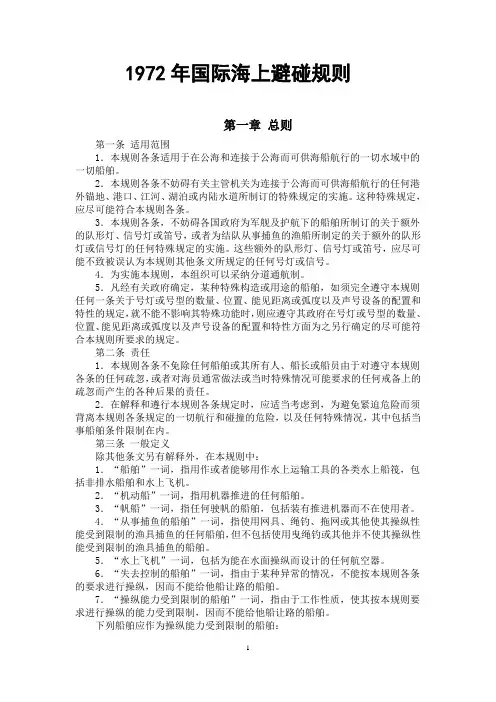
1972年国际海上避碰规则第一章总则第一条适用范围1.本规则各条适用于在公海和连接于公海而可供海船航行的一切水域中的一切船舶。
2.本规则各条不妨碍有关主管机关为连接于公海而可供海船航行的任何港外锚地、港口、江河、湖泊或内陆水道所制订的特殊规定的实施。
这种特殊规定,应尽可能符合本规则各条。
3.本规则各条,不妨碍各国政府为军舰及护航下的船舶所制订的关于额外的队形灯、信号灯或笛号,或者为结队从事捕鱼的渔船所制定的关于额外的队形灯或信号灯的任何特殊规定的实施。
这些额外的队形灯、信号灯或笛号,应尽可能不致被误认为本规则其他条文所规定的任何号灯或信号。
4.为实施本规则,本组织可以采纳分道通航制。
5.凡经有关政府确定,某种特殊构造或用途的船舶,如须完全遵守本规则任何一条关于号灯或号型的数量、位置、能见距离或弧度以及声号设备的配置和特性的规定,就不能不影响其特殊功能时,则应遵守其政府在号灯或号型的数量、位置、能见距离或弧度以及声号设备的配置和特性方面为之另行确定的尽可能符合本规则所要求的规定。
第二条责任1.本规则各条不免除任何船舶或其所有人、船长或船员由于对遵守本规则各条的任何疏忽,或者对海员通常做法或当时特殊情况可能要求的任何戒备上的疏忽而产生的各种后果的责任。
2.在解释和遵行本规则各条规定时,应适当考虑到,为避免紧迫危险而须背离本规则各条规定的一切航行和碰撞的危险,以及任何特殊情况,其中包括当事船舶条件限制在内。
第三条一般定义除其他条文另有解释外,在本规则中:1.“船舶”一词,指用作或者能够用作水上运输工具的各类水上船筏,包括非排水船舶和水上飞机。
2.“机动船”一词,指用机器推进的任何船舶。
3.“帆船”一词,指任何驶帆的船舶,包括装有推进机器而不在使用者。
4.“从事捕鱼的船舶”一词,指使用网具、绳钓、拖网或其他使其操纵性能受到限制的渔具捕鱼的任何船舶,但不包括使用曳绳钓或其他并不使其操纵性能受到限制的渔具捕鱼的船舶。
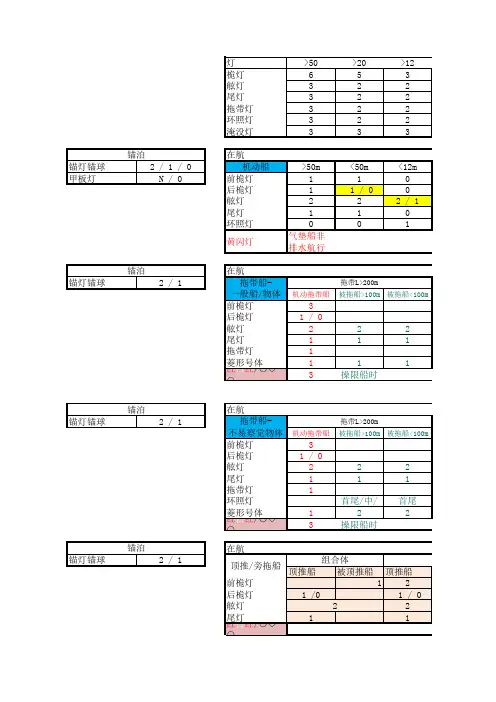
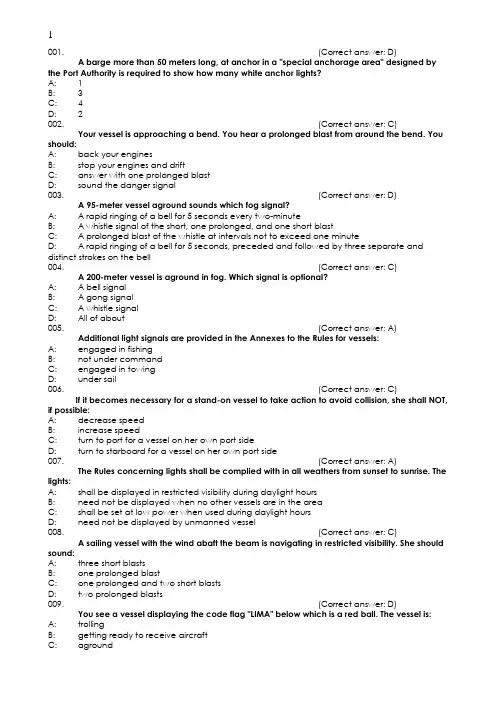
001. (Correct answer: D)A barge more than 50 meters long, at anchor in a "special anchorage area" designed by the Port Authority is required to show how many white anchor lights?A: 1B: 3C: 4D: 2002. (Correct answer: C) Your vessel is approaching a bend. You hear a prolonged blast from around the bend. You should:A: back your enginesB: stop your engines and driftC: answer with one prolonged blastD: sound the danger signal003. (Correct answer: D)A 95-meter vessel aground sounds which fog signal?A: A rapid ringing of a bell for 5 seconds every two-minuteB: A whistle signal of the short, one prolonged, and one short blastC: A prolonged blast of the whistle at intervals not to exceed one minuteD: A rapid ringing of a bell for 5 seconds, preceded and followed by three separate and distinct strokes on the bell004. (Correct answer: C)A 200-meter vessel is aground in fog. Which signal is optional?A: A bell signalB: A gong signalC: A whistle signalD: All of about005. (Correct answer: A) Additional light signals are provided in the Annexes to the Rules for vessels:A: engaged in fishingB: not under commandC: engaged in towingD: under sail006. (Correct answer: C) If it becomes necessary for a stand-on vessel to take action to avoid collision, she shall NOT, if possible:A: decrease speedB: increase speedC: turn to port for a vessel on her own port sideD: turn to starboard for a vessel on her own port side007. (Correct answer: A) The Rules concerning lights shall be complied with in all weathers from sunset to sunrise. The lights:A: shall be displayed in restricted visibility during daylight hoursB: need not be displayed when no other vessels are in the areaC: shall be set at low power when used during daylight hoursD: need not be displayed by unmanned vessel008. (Correct answer: C)A sailing vessel with the wind abaft the beam is navigating in restricted visibility. She should sound:A: three short blastsB: one prolonged blastC: one prolonged and two short blastsD: two prolonged blasts009. (Correct answer: D) You see a vessel displaying the code flag "LIMA" below which is a red ball. The vessel is:A: trollingB: getting ready to receive aircraftC: agroundD: in distress010. (Correct answer: D) Which statement is TRUE concerning seaplanes on the water?A: a seaplane must show appropriate lights but need not exhibit shapes.B: a seaplane should exhibits the lights for a vessel constrained by her draft.C: in situations where a risk of collision exists, a seaplane should always give way.D: a seaplane on the water shall, in general, keep well clear of all vessel.011. (Correct answer: B)A vessel approaching your vessel from 235 degrees relative is in what typeA: Meeting.B: Overtaking.C: Crossing.D: Passing.012. (Correct answer: C) You are underway and hear a vessel continuously sounding her fog whistle. This indicates the other vessel:A: desires to communicate by radioB: desires a pilotC: is in distressD: is aground013. (Correct answer: D) Which statement is TRUE concerning a vessel of 75 meters in length at anchor?A: She must show an all-round white light forward.B: She must show a second all-round white light aft.C: She may use her working lights to illuminate her decks.D: All of the above.014. (Correct answer: C) You are approaching another vessel. She is about one mile distant and is on your starboard bow. You believe she will cross ahead of you. She then sounds a whistle signal of five short blasts. You should:A: answer the signal and hold course and speedB: reduce speed slightly to make sure she will have room to passC: make a large course change, and slow down if necessaryD: wait for another whistle signal from the other vessel015. (Correct answer: D) If a rowboat underway does NOT show the lights specified for a sailing vessel underway, it shall show a:A: white light from sunset to sunriseB: combined lantern showing green to starboard and red to port and shown from sunset to sunriseC: combined lantern showing green to starboard and red to port and shown in sufficient time to prevent collisionD: white light shown in sufficient time to prevent collision016. (Correct answer: D) Which vessel must show an after masthead light, is over 50 meters in length?A: A vessel engaged in fishingB: A vessel at anchorC: A vessel not under commandD: A vessel trawling017. (Correct answer: B) An authorized light to assist in the identification of submarines operating on the surface isa(n):A: a blue rotating lightB: intermittent flashing amber/ yellow lightC: flashing white lightD: flashing sidelight018. (Correct answer: D)A lookout should report objects sighted using:A: true bearingsB: magnetic bearingsC: gyro bearingD: relative bearings019. (Correct answer: C) Which is the danger signal?A: A continuous sounding of the fog signalB: Firing a gun every minuteC: Five or more short rapid blasts on the whistleD: One prolonged blast on the whistle020. (Correct answer: C) Continuous sounding of a fog whistle by a vessel is a signal:A: that the vessel is anchoredB: to request the draw span of a bridge to the openedC: of distressD: that the vessel is broken down and drifting021. (Correct answer: A) What does the helm command "SHIFT THE RUDDER" mean?A: Put the rudder over to the opposite side, the same number of degrees it is now.B: Put the rudder amidships and hold the heading steady as she goes.C: Shift the rudder control to the alternate steering method.D: Stop the swing of the ship.022. (Correct answer: C)A vessel, which is unable to maneuver due to some exceptional circumstance, shall exhibit: A: during the day, three balls in a vertical lineB: during the day, three shapes, the highest and the lowest being balls and the middle being a diamondC: when making way at night, two all-round red lights and, sidelights, and sternlightD: when making way at night, a masthead light, sidelights and a sternlight023. (Correct answer: C) Which statement is TRUE concerning the light used with whistle signals?A: Use of such a light is required.B: The light shall have the same characteristics as a masthead light.C: It is only used to supplement short blasts on the whistle.D: All of the above.024. (Correct answer: A)A lantern combining a vessel's running lights may be shown on a .A: A 15-meter sailing vesselB: 20-meter vessel engaged in fishing and making wayC: 25-meter power-driven vessel trawlingD: 25-meter pilot vessel025. (Correct answer: D)A vessel engaged in fishing during the day would show .A: one black ballB: two cones with bases togetherC: a cone, apex downwardD: two cones, apexes together026. (Correct answer: D) Which vessel may sound the danger signal ?A: The stand-on vessel in a crossing situation.B: The give-way vessel in a crossing situation.C: A vessel at anchor.D: All of the above.027. (Correct answer: C) Which display indicates a vessel conducting mineclearance operations ?A: Three balls in a vertical line.B: Two balls in vertical line.C: One ball near the foremast and one ball at each yardarm.D: One diamond near foremast and one ball at each yardarm.028. (Correct answer: A)The duration of each blast of the whistle signals used in meeting and crossing situations is: A: about 1 secondB: 2 or 4 secondsC: 4 to 6 secondsD: 8 to 10 seconds029. (Correct answer: B) What type of vessel or operation is indicated by a vessel displaying two cones with the apexes together ?A: SailingB: TrawlingC: MinesweepingD: Dredging030. (Correct answer: A) The helm command "STEADY AS YOU GO" means:A: steer the course you are on nowB: steer the course when the swing stopsC: maintain the rate of swingD: don't allow the vessel to swing off course so much031. (Correct answer: C) "EASE THE RUDDER" means to:A: move the rudder slowly in the direction of the most recent rudder commandB: bring the rudder amidshipsC: decrease the rudder angleD: steer the course which is your present heading032. (Correct answer: D) The rule regarding lookout applies:A: in restricted visibilityB: between dusk and dawnC: in heavy trafficD: All of the above.033. (Correct answer: A) At night, a vessel which is less than 7 meters in length and anchoring in an area where other vessels do not normally navigate is:A: not required to show any anchor lightsB: required to show a flare-up lightC: required to show one white lightD: required to show sidelights and a sternlights034. (Correct answer: A) While underway in fog you hear a vessel sound one prolonged blast followed by two short blasts. What does this signal indicate ?A: A vessel towingB: A vessel being towingC: A pilot vessel engaged on pilot dutyD: A vessel aground035. (Correct answer: C)A vessel transferring cargo while underway is classified by the Rules as vessel:A: not under commandB: in special circumstancesC: restricted in her ability to maneuverD: constrained by her draft036. (Correct answer: C) Which vessel, when anchored at night, is NOT required to show anchor lights ?A: A power-driven vesselB: A vessel engaged on pilotage dutyC: A vessel dredgingD: A vessel restricted in her ability to maneuver037. (Correct answer: D)A vessel towing is showing three forward white masthead lights in a vertical line. This means that the length of the:A: towing vessel is less than 50 metersB: towing vessel is greater than 50 metersC: tow is less than 200 metersD: tow is greater than 200 meters038. (Correct answer: C) Which vessel is “underway" under the Rules of COLREG-72 ?A: A vessel at anchor with the engine runningB: A vessel with a line led to a tree onshoreC: A vessel drifting with the engine offD: A vessel aground039. (Correct answer: C)A 25-meter vessel trawling will show the day shape(s) consisting of:A: a basketB: two ballsC: two cones, apexes togetherD: a cone, apex downward040. (Correct answer: D)A power-driven vessel underway shall keep out of the way of a:A: vessel not under commandB: vessel engaged in fishingC: sailing vesselD: all of the above041. (Correct answer: A)A continuous sounding of a fog - signal apparatus indicates:A: the vessel is in distressB: the vessel has completed loading dangerous cargoC: it is safe to passD: the vessel is anchored042. (Correct answer: B) While underway in fog you hear a whistle signal consisting of one prolonged blast followed immediately by two short blasts. This signal is sounded in fog by:A: a vessel at anchorB: a vessel underway and towingC: a vessel in dangerD: a pilot vessel043. (Correct answer: C) While moving ahead, a twin-screw ship has an advantage over a single-screw ship because:A: correct trim will be obtained more easilyB: drag effect will be canceled outC: side forces will be eliminatedD: speed will be increased044. (Correct answer: D) Which statement is TRUE of a 30-meters sailing vessel underway ?A: She must show sidelights and a sternlight in restricted visibility.B: She may show an all-round white light at the top of the mast.C: She need not show a sternlight if she is showing all-round light on the mast.D: If she is using propelling machinery, she shall show where it can be best seen a conical shape, apex downwards.045. (Correct answer: B)A power-driven vessel towing another vessel astern (tow less than 200 meters) shall show: A: three masthead lights in a vertical line instead of either the forward of after masthead light B: two masthead lights in a vertical line instead of either the forward or after masthead lights C: two towing lights in a vertical line at the sternD: a small white light aft of the funnel046. (Correct answer: A)A vessel which is "restricted in her ability to maneuver" under the Rules, is a vessel which is: A: mineclearingB: engaged in fishingC: at anchorD: not under command047. (Correct answer: B) When a vessel signals her distress by means of a gun or other explosive signal, the firing should be at intervals of approximately:A: 10 minutesB: 1 minuteC: 1 hourD: 3 minutes048. (Correct answer: D)A "head on" situation shall be deemed to exist at night when a power-driven vessel sees another power-driven vessel ahead and:A: one sidelight and the masthead light are visibleB: the vessels will pass closer than half a mileC: both vessels sound one prolonged blastD: both sidelights and masthead light(s) are visible049. (Correct answer: B)A 20-meter vessel is towing another vessel astern. The length of the tow from the stern of the towing vessel to the stern of the tow is 75 meters. How many white towing masthead lights shall the towing vessel show at night ?A: 1B: 2C: 3D: 4050. (Correct answer: B) You are stopped with no way upon your vessel at the pilot station. Your vessel is a large twin-screw ship. You must come around 180( to board your Pilot. How should you use the engines and rudder to turn the ship tastiest in the least amount of space ?A: Full ahead on the engines and hard over rudderB: Full ahead on one engine, full astern on the otherC: Half ahead with hard over rudder, then full astern on inboard engineD: Slow ahead with hard over rudder051. (Correct answer: D)A vessel engaged in fishing, and at anchor, shall show .A: an anchor lightB: sidelights and a sternlightsC: three lights in a vertical line, the highest and lowest being red, and the middle being white D: None of the above052. (Correct answer: C)A vessel sounding a fog signal of one short, one prolonged, and one short blast is indicating that the vessel is:A: fishingB: in distressC: at anchorD: not under command053. (Correct answer: D) Two all-round red lights displayed in vertical line are shown by a vessel .A: being towedB: pushing a barge aheadC: at anchorD: not under command054. (Correct answer: A) You are underway in fog and you hear one prolonged blast followed by two short blasts. This is a vessel:A: towingB: engaged on pilotageC: aground in a fairwayD: stopped and making no way through the water055. (Correct answer: B)According to the Rules, which vessel is NOT "restricted in her ability to maneuver" ?A: A vessel servicing a navigation markerB: A sailing vesselC: A vessel mineclearingD: A vessel dredging056. (Correct answer: C)A vessel which is unable to maneuver due to same exceptional circumstance, shall show two red lights in a vertical line and:A: during the day, three balls in a vertical lineB: during the day, three shapes, the highest and lowest being balls and the middles being diamondC: when making way at night, sidelights and a sternlightD: when making way at night, masthead lights, sidelights and a sternlight057. (Correct answer: A) You are underway and approaching a bend in the channel where vessels approaching from the opposite direction cannot be seen. You should sound:A: one blast, 4 or 6 seconds in durationB: three blasts, 4 or 6 seconds in durationC: one continuous blast until you are able to see around the bendD: one blast, 8 or 10 seconds in duration058. (Correct answer: D)A vessel which is fishing must show sidelights and a sternlights only when:A: anchoredB: underwayC: dead in the waterD: underway and making way059. (Correct answer: B) The rudder is amidships and both screws are going ahead. What will happen if the starboard screw is stopped ?A: The bow will go to port.B: The bow will go to the starboard.C: The bow will remain steady.D: The stern will go to starboard.060. (Correct answer: B)A power-driven vessel towing astern shall show .A: two towing lights in a vertical lineB: a towing light in a vertical line above the sternlightC: two towing lights in addition to the sternlightD: a small white light in lieu of the sternlight061. (Correct answer: C) You are underway in fog when you hear the following signal: one short blast, one prolonged blast and one short blast in succession. Which of the following would it be ?A: A sailing vessel underway with the wind abaft the beam.B: A power-driven vessel underway and making way through the water.C: A vessel at anchor.D: A vessel towing.062. (Correct answer: D)A twin-screw vessel can clear the inboard propeller and maneuver off a pier BEST by holding:A: forward spring line and going slow ahead on the inboard engineB: after spring line and going slow astern on the outboard engineC: forward spring line and going slow ahead on both enginesD: forward spring line and going slow ahead on the outboard engine063. (Correct answer: B) If you hear the firing of a gun at one-minute intervals from another vessel, this indicates that: A: the gun is being used to sound passing signalsB: the vessel is in distressC: all vessels are to clear the areaD: all is clear and it is safe to pass064. (Correct answer: D) Fog signals, required under the Rules for vessels underway, shall be sounded:A: only on the approach of another vesselB: only when vessels are in sight of each otherC: at intervals of not more than one minuteD: at intervals of not more than two minutes065. (Correct answer: C)A towing vessel is towing two barges astern. The length of the tow from the stern of the tug to the stern of the last barge is 250 meters. The towing vessel is 45 meters in length. How many white masthead lights should be displayed on the towboat at night ?A: 1B: 2C: 3D: 4066. (Correct answer: C) At night, a vessel shall indicate that she is restricted in her ability to maneuver by showing in a vertical line two .A: red lightsB: red lights and two white lightsC: red lights with a white light in betweenD: white lights with a red light in between067. (Correct answer: B) Your power-driven vessel is underway when you sight a sailing vessel on your port bow. Which vessel is the "stand-on" vessel ?A: The sailboat, because it is to port of your vesselB: The sailboat, because it is under sailC: Your vessel, because it is a power-driven vesselD: Your vessel, because it is to starboard of the sailboat068. (Correct answer: A) Five or more short blasts on a vessel's whistle indicates that she is:A: in doubt that another vessel is taking sufficient action to avoid a collisionB: altering course to starboardC: altering course to portD: the stand-on vessel and will maintain course and speed069. (Correct answer: B) Which statement concerning maneuvering in restricted visibility is FALSE ?A: a vessel which cannot avoid a close-quarters situation with a vessel forward of her beam shall reduce her speed to bare steerageway.B: a vessel which hears a fog signal forward of her beam shall stop her engines.C: A vessel which hears a fog signal forward of the beam shall navigate with caution.D: If a vessel determines by radar that a close-quarters situation is developing, she shall take avoiding action in ample time.070. (Correct answer: C)A twin-screw vessel, making headway with both engines turning ahead, will turn more readily to starboard if you .A: reverse port engine, apply right rudderB: reverse port engine, rudder amidshipsC: reverse starboard engine, apply right rudderD: reverse starboard engine, rudder amidships071. (Correct answer: D)A vessel being towed astern shall show at night .A: the lights required for a power-driven vessel underwayB: only the required masthead lightsC: a sternlight onlyD: sidelights and sternlight072. (Correct answer: C) In order for a stand-on vessel to take action in a situation, she must determine that the other vessel .A: is restricted in her ability to maneuverB: has sounded the danger signalC: is not taking appropriate actionD: has not changed course since risk of collision was determined073. (Correct answer: C) While underway your vessel approaches a bend in a river where, due to the bank, you cannot see around the bend. You should .A: keep to the starboard side of the channel and sound one short blastB: sound the danger signalC: sound one prolonged blastD: slow your vessel to bare steerageway074. (Correct answer: B) You are approaching a narrow channel. You see a vessel that can only be navigated safely within the channel. You should .A: initiate an exchange of passing signalsB: not cross the channel if you might impede the mother vesselC: sound the danger signalD: hold your course and speed075. (Correct answer: D) Your 15-meter vessel is crossing a narrow channel and a large cargo vessel to port is within the channel and crossing your course. You must .A: hold course and speedB: sound the danger signalC: initiate an exchange of passing signalsD: do not cross the channel if you might impede the other vessel076. (Correct answer: B) You are crossing a narrow channel in a 15-meter vessel when you sight a tanker off your port bow coming up the channel. Which statement is TRUE ?A: Yours is the give-way vessel because it is less than 30 meters long.B: You shall not impede the safe passage of the tanker.C: The tanker is the stand-on vessel because it is to port of your vessel.D: The tanker is the stand-on vessel because it is the larger of the two vessels.077. (Correct answer: D) If your vessel is underway in fog and you hear one prolonged and three short blasts, this indicates a .A: vessel not under commandB: sailing vesselC: vessel in distressD: vessel being towed078. (Correct answer: C) At night, which lights would see on a vessel engaged in fishing, other than trawling ?A: Two red lights, one over the other.B: A green light over a red light.C: A red light over a white light.D: A white light over a red light079. (Correct answer: B) Systems of inbound and outbound lanes to promote the safe flow of vessel traffic in certain areas around the world are known as .A: merchant vessel reporting systemsB: traffic separation schemesC: collision avoidance fairwaysD: restricted maneuverability channels080. (Correct answer: A)A tug is towing three manned barges in line in fog. The first vessel of the tow should sound . A: no fog signalB: one short blastC: one prolonged and three shot blastsD: one prolonged, one short, and one prolonged blast081. (Correct answer: C) All fog signals shall be sounded every two minutes with the EXCEPTION of a vessel .A: underway or making wayB: under sail or under towC: anchored or agroundD: not under command or restricted in her ability to maneuver082. (Correct answer: B)A 200-meter vessel restricted in her ability to maneuver, at anchor, will sound a fog signal of A: a 5 second ringing of a bell forward and a 5 second sounding of a gong aft at intervals of 1 minuteB: one prolonged followed by two short blasts every minuteC: one prolonged followed by three short blasts every minuteD: one prolonged followed by three short blasts every 2 minutes083. (Correct answer: A)A partially submerged object towed by a vessel must show during the day .A: one diamond shape when the length of the tow is 200 meters or lessB: one diamond shape ONLY when the length of the tow exceeds 200 meters in lengthC: one black ballD: one black ball ONLY when the length of the tow exceeds 200 meters in length084. (Correct answer: B) Anchors are prevented from running out when secured by the .A: brakeB: devil's clawC: pawlsD: all of the above085. (Correct answer: D) What dayshape is to shown by a vessel aground ?A: A cylinderB: Two cones with their apexes togetherC: Two black balls in a vertical lineD: Three black balls in a vertical line086. (Correct answer: D) What is NOT a distress signal ?A: Red flares or red rocketsB: Continuous sounding of fog signaling apparatusC: International Code Flags "NOVEMBER" and "CHARLIE"D: Basket handing in the rigging087. (Correct answer: A) Which statement is TRUE concerning a vessel equipment with operational radar ?A: She must use this equipment to obtain early warning of risk of collision.B: The use of a radar excuses a vessel from the need of a lookout.C: The radar equipment is only required to be used in restricted visibility.D: The safe speed of such a vessel will likely be greater than that of vessels without radar. 088. (Correct answer: D) You are underway in restricted visibility and hear a fog signal forward of the beam. Nothing appear on your radar screen. You must .A: stop your enginesB: sound two prolonged blasts of the whistleC: sound the danger signalD: slow to bare steerageway089. (Correct answer: C) What is the optional whistle signal which may be sounded by a vessel at anchor ?A: Two prolonged followed by one short blasts.B: One short followed by two prolonged blasts.C: One short, one prolonged, followed by one short blast.D: Four short blasts.090. (Correct answer: B) The minimum length of a power-driven that must show forward and after masthead lights is A: 30 metersB: 50 metersC: 75 metersD: 100 meters091. (Correct answer: D) The part of the anchor which takes hold on the bottom is the .A: armB: baseC: flukeD: stock092. (Correct answer: D) What light(s), if any, would you show at night if your vessel was broken down and being towed by another vessel ?A: None.B: Same lights as for a power-driven vessel underwayC: A white light forward and white light aftD: The colored sidelights and a white sternlight093. (Correct answer: D)A vessel not under command making way at night would show .A: two all-round red lights in a vertical lineB: anchor lights and running lightsC: two all-round white lights in a vertical line, sidelights and a sternlightD: two all-round red lights in a vertical line, sidelights and a sternlight094. (Correct answer: A) In a dense fog, you hear a whistle signal of one prolonged blast followed by three short blasts. This signal is sounded by a .A: manned vessel being towedB: fishing vessel underway trawlingC: pilot vessel underway making a special signalD: vessel not under command095. (Correct answer: C) While underway and pushing a barge ahead, your vessel enters a heavy rainstorm. You should sound .A: a prolonged blast every two minutesB: two prolonged blasts every two minutesC: one prolonged and two short blasts every two minutesD: one prolonged and three short blasts every two minutes096. (Correct answer: D) On open waters, a power-driven vessel shall keep out of the way of aA: vessel on her port side that is crossing her courseB: vessel that is overtaking herC: seaplane on the waterD: sailing vessel097. (Correct answer: C) You are overtaken a vessel at night and you see a yellow light showing above the sternlight of the overtaken vessel. The overtaken vessel is .A: underway and dredgingB: pushing ahead or towing alongsideC: towing asternD: a pilot vessel098. (Correct answer: D) Your vessel is at anchor in fog. The fog signal of another vessel, apparently underway, has been growing louder and the danger of collision appears to exist. In addition to your fog signal, what signal may be used to indicate your presence ?A: No signal other than your fog signal may be used.B: One prolonged, one short, and one prolonged whistle blasts.C: One prolonged followed by two short whistle blasts.D: One short, one prolonged, and one short whistle blast.099. (Correct answer: C)A tug is towing three manned barges in line in fog. The third vessel of the tow should sound . A: a fog signal。
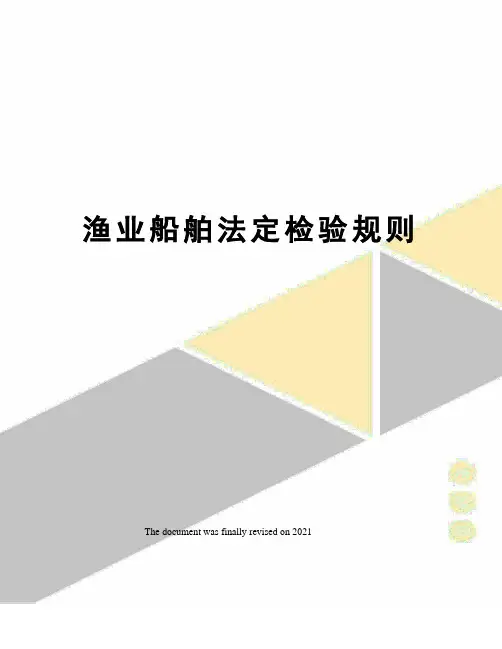
渔业船舶法定检验规则 The document was finally revised on 2021第二篇检验与发证第1章通则第1节一般规定1.1.1 渔业船舶的所有人、经营者或代理人(以下简称船舶所有人)须按本篇的规定申报检验。
1.1.2 所有渔业船舶在首次投入营运之前须申报初次检验。
1.1.3 营运渔业船舶须按本篇规定申报营运船舶检验。
1.1.4 船舶所有人须按本篇规定申报吨位丈量、核定载重线。
1.1.5 渔业船舶的主要船用产品,须按本篇的规定申报产品检验。
1.1.6 验船部门受理检验的范围,须按主管机关的规定执行。
1.1.7 检验依据1.1.7.1 本规则是执行渔业船舶法定检验的依据。
1.1.7.2 主管机关颁布的其他规定是本规则的组成部分。
1.1.7.3 除另有明文规定外,主管机关颁布的指导性文件均属于非强制性的。
1.1.7.4 渔业船舶结构除须符合本规则的相应规定外,其船舶强度、结构、布置、材料、构件尺寸、机械设备、电气设备、冷藏装置、防火结构、焊接、锅炉和其他受压容器及其附件等,其设计与安装应适用于预定的用途,且应符合主管机关颁布或承认的建造规范、标准的有关规定。
1.1.7.5 本规则各篇的规定已涵盖了下列有关国际公约、议定书(包括修正案)、规则等对渔业船舶的要求:1) 1969年国际船舶吨位丈量公约(简称69吨位公约);2) 1966年国际船舶载重线公约及1988年议定书(简称66载重线公约);3) 1974年国际海上人命安全公约及其议定书和修正案(简称SOLAS 公约1974);4) 1972年国际海上避碰规则及其修正案(简称72避碰规则);5) 1973年国际防止船舶造成污染公约78年议定书及1988年议定书(简称MARPOL 73/78公约);6) 1977年托雷莫利诺斯国际渔船安全公约1993年议定书(简称93议定书)。
1.1.7.6 本规则还包括了国际劳工组织(简称ILO)于1932年修订的《关于船舶装卸作业防止工人工伤事故公约》(简称32号公约),以及替代并于1981年12月5日生效的相应公约(简称152公约)的有关内容。
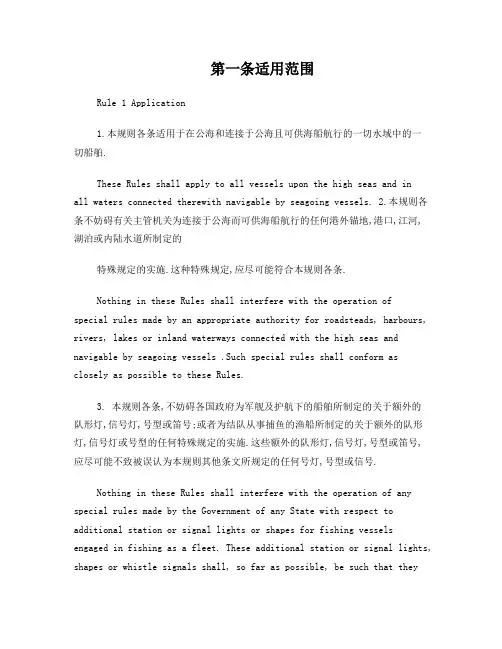
第一条适用范围Rule 1 Application1.本规则各条适用于在公海和连接于公海且可供海船航行的一切水域中的一切船舶.These Rules shall apply to all vessels upon the high seas and inall waters connected therewith navigable by seagoing vessels. 2.本规则各条不妨碍有关主管机关为连接于公海而可供海船航行的任何港外锚地,港口,江河,湖泊或内陆水道所制定的特殊规定的实施.这种特殊规定,应尽可能符合本规则各条.Nothing in these Rules shall interfere with the operation ofspecial rules made by an appropriate authority for roadsteads, harbours, rivers, lakes or inland waterways connected with the high seas and navigable by seagoing vessels .Such special rules shall conform asclosely as possible to these Rules.3. 本规则各条,不妨碍各国政府为军舰及护航下的船舶所制定的关于额外的队形灯,信号灯,号型或笛号;或者为结队从事捕鱼的渔船所制定的关于额外的队形灯,信号灯或号型的任何特殊规定的实施.这些额外的队形灯,信号灯,号型或笛号,应尽可能不致被误认为本规则其他条文所规定的任何号灯,号型或信号.Nothing in these Rules shall interfere with the operation of any special rules made by the Government of any State with respect to additional station or signal lights or shapes for fishing vessels engaged in fishing as a fleet. These additional station or signal lights, shapes or whistle signals shall, so far as possible, be such that theycannot be mistaken for any light, shape or signal authorized elsewhere under these Rules.4.为实施本规则,本组织可以采纳分道通航制.Traffic separation schemes may be adopted by the Organization for the purpose of these Rules.5.凡经有关政府确定,某种特殊构造或用途的船舶,如不能完全遵守本规则任何一条关于号灯或号型的数量,位置,能见距离或弧度以及声号设备的配置和特性的规定时,则应遵守其政府在号灯或号型的数量,位置,能见距离或弧度以及声号设备的配置和特性方面为之另行确定的尽可能符合本规则要求的规定.Whenever the Government concerned shall have determined that a vessel of special construction or purpose cannot comply fully with the provisions of any of these Rules with respect to the number, position, range or arc of visibility of lights or shapes, as well as to the disposition and characteristics of sound-signalling appliances, such vessel shall comply with such other provisions in regard to the number, position ,range or arc of the visibility of lights or shapes, as well as to the disposition and characteristics of sound-signalling appliances, as her Government shall have determined to be the closest possible compliance with these Rules in respect of that vessel.第二条责任Rule 2 Responsibility1.本规则各条并不免除任何船舶或其所有人,船长或船员由于对遵守本规则各条的任何疏忽,或者对海员通常做法或当时特殊情况可能要求的任何戒备上的疏忽而产生的各种后果的责任.Nothing in these Rules shall exonerate any vessel, or the owner, master or crew thereof, from the consequences of any neglect to comply with these Rules or of the neglect of any precaution which may be required by the ordinary practice of seamen, or by the special circumstances of the case.2.在解释和遵行本规则各条规定时,应适当考虑到,为避免紧迫危险而需背离本规则各条规定的一切航行和碰撞的危险,以及任何特殊情况,其中包括当事船舶条件限制在内.In construing and complying with these Rules due regard shall be had to all dangers of navigation and collision and to any special circumstances, including the limitations of the vessels involved, which may make a departure from these Rules necessary to avoid immediate danger.第三条一般定义Rule 3 General definitions除其他条文另有解释外,在本规则中:For the purpose of these Rules, except where the context otherwise requires:1.“船舶”一词,指用作或者能够用作水上运输工具的各类水上船筏,包括非排水船舶,水上飞机和地效翼船.The word “vessel”includes every description of water craft, including non-displacement craft ,WIG craft and seaplanes, used or capable of being used as a means of transportation on water.2.“机动船”一词,指用机器推进的任何船舶.The term“power-driven vessel ”means ay vessel propelled by machinery.3.“帆船”一词,指任何驶帆的船舶,包括装有推进机器而不在使用者.The term “sailing vessel”means any vessel under sail providedthat propelling machinery, if fitted, is not being used.4.“从事捕鱼的船舶”一词,指使用网具绳钓拖网或其他使其操纵性能受到限制的渔具捕鱼的任何船舶,但不包括使用曳绳钓或其他并不使其操纵性能受到限制的渔具捕鱼的船舶.The term “vessel engaged in fishing”means any vessel fishing with nets, lines, trawls or other fishing apparatus which restrict manoeuvrability , but does not include a vessel fishing with trolling lines or other fishing apparatus which do not restrict manoeuvrability.5.“水上飞机”一词,包括为能在水面操纵而设计的任何航空器.The word“seaplane”includes any aircraft designed to manoeuvre on the water.6.“失去控制的船舶”一词,指由于某种异常的情况不能按本规则各条的要求进行操纵,因而不能给他船让路的船舶.The term “vessel not under command”means a vessel which through some exceptional circumstance is unable to manoeuvre as required by these Rules and is therefore unable to keep out of the way of another vessel.7.“操纵能力受到限制的船舶”一词,指由于工作性质,使其按本规则要求进行操纵的能力受到限制,因而不能给他船让路的船舶. 操纵能力受到限制的船舶一词应包括,但不限于下列船舶:The t erm “vessel restricted in her ability to manoeuvre”means a vessel which from the nature of her work is restricted in her ability to manoeuvre as required by these Rules and is therefore unable to keep out of the way of another vessel. The term vessels restricted in theirability to manoeuvre shall include but not be limited to:(1)从事敷设,维修或起捞助航标志,海底电缆或管道的船舶;A vessel engaged in laying, servicing or picking up a navigation mark, submarine cable or pipeline.(2)从事疏浚,测量或水下作业的船舶;A vessel engaged in dredging, surveying or underwater operations.(3)在航中从事补给或转运人员,食品或货物的船舶;A vessel engaged in replenishment or transferring persons, provisions or cargo while underway.(4)从事发放或回收航空器的船舶;A vessel engaged in the launching or recovery of aircraft.(5)从事清除水雷作业的船舶;A vessel engaged in mine clearance operations.(6)从事拖带作业的船舶,而该项拖带作业使该拖船及其被拖船偏离所驶航向的能力严重受到限制.A vessel engaged in a towing operation such as severely restricts the towing vessel and her tow in their ability to deviate from their course.8.“限于吃水的船舶”一词,指由于吃水与可航水域的水深和宽度的关系,致使其偏离航向的能力严重的受到限制的机动船.The term “vessel constrained by her draught ”means a power-driven vessel which, because of her draught in relation to the available depth and width of navigable water, is severely restricted in her ability to deviate from the course she is following.9.“在航”一词,指船舶不在锚泊,系岸或搁浅.The word“underway”means that a vessel is not at anchor, or made fast to the shore, or aground.10.船舶的“长度和宽度”是指其总长度和最大宽度.The words “length and breadth” of a vessel mean her length overall an d greatest breadth.11.只有当一船能自他船以视觉看到时,才应认为两船是在互见中.Vessel shall be deemed to be in sight of one another only when one can be observed visually from the other.12“能见度不良”一词,指任何由于雾,霾,下雪,暴风雨,沙暴或任何其他类似原因而使能见度受到限制的情况.The term “restricted visibility” me ans any condition in which visibility is restricted by fog, mist, falling snow, heavy rainstorms, sandstorms or any other similar causes.13.“地效翼船”是一种模式的船艇,其主要操作模式是利用表面效应在相当接近水面的高度飞行.The term “Wing-In-Ground (WIG) craft” means a multimodal craft which, in its main operational mode flies in close proximity to the surface-effect action.第四条适用范围Rule 4 application本节各条适用于任何能见度的情况Rules in this section apply in any condition of visibility.第五条了望Rule 5 look-out每一船舶应经常用视觉,听觉以及适合当时环境和情况下一切有效的手段保持正规的了望,以便对局面和碰撞危险作出充分的估计.Every vessel shall at all times maintain a proper look-out by sight and hearing as well as by all available means appropriate in the prevailing circumstances and conditions so as to make a full appraisal of the situation and of the risk of collision.第六条安全航速Rule 6 safe speed每一船舶在任何时候均应用安全航速行驶,以便能采取适当而有效的避碰行动并能在适合当时环境和情况的距离以内把船停住.在决定安全航速时,考虑的因素中应包括下列各点:Every vessel shall at all times proceed at a safe speed so that she can take proper and effective action to avoid collision and be stopped within a distance appropriate to the prevailing circumstances and conditions. In determining a safe speed the following factors shall be among those taken into account:1.对所有船舶: By all vessels:(1)能见度情况; the state of visibility;(2)通航密度,包括渔船或者任何其他船舶的密集程度;The traffic density including concentrations of fishing vessels or any other vessels.(3)船舶的操纵性能,特别是在当时情况下的冲程和回转性能;The manoeuvrability of the vessel with special reference to stopping distance and turning ability in the prevailing conditions. (4)夜间出现的背景亮光,诸如来自岸上灯光或本船灯光的反向散射;At night the presence of background light such as from shore lights or from backscatter of her own lights.(5)风,浪和流的状况以及靠近航海危险物的情况;The state of wind, sea and current, and the proximity of navigational hazards(6)吃水与可用水深的关系.The draught in relation to the available depth of water.2.对备有可使用的雷达的船舶,还需考虑:Additionally, by vessels with operational radar:(1)雷达设备的特性,效率和局限性;The characteristics, efficiency and limitations of the radar equipment.(2)所选用的雷达距离标尺带来的任何限制;Any constraints imposed by the radar range scale in use.(3)海况,天气和其他干扰源对雷达探测的影响;The effect on radar detection of the sea state, weather and other sources of interference.(4)在适当距离内,雷达对小船,浮冰和其他漂浮物有探测不到的可能性;The possibility that small vessels, ice and other floating objects may not be detected by radar at an adequate range.(5)雷达探测到的船舶数目,位置和动态;The number, location and movement of vessels detected by radar.(6)当用雷达测定附近船舶或其他物体的距离时,可能对能见度作出的更确切的估计.The more exact assessment of the visibility that may be possible when radar is used to determine the range of vessels or other objects in the vicinity.第七条碰撞危险Rule 7 risk of collision1.每一船舶应用适合当时环境和情况的一切有效手段断定是否存在碰撞危险,如有任何怀疑,则应认为存在这种危险. Every vessel shall use all available means appropriate to the prevailing circumstances and conditions to determine if risk of collision exists, if there is any doubt such risk shall be deemed to exists.2.如装有雷达设备并可使用的话,则应正确予以使用,包括远距离扫描,以便获得碰撞危险的早期报警,并对探测到的物标进行雷达标绘或与其相当的系统观察.Proper use shall be made of radar equipment if fitted and operational, including long-range scanning to obtain early warning of risk of collision and radar plotting or equivalent systematic observation of detected objects.3.不应当根据不充分的资料,特别是不充分的雷达观测资料作出推断.Assumptions shall not be made on the basis of scanty information, especially scanty radar information4.在断定是否存在碰撞危险时,考虑的因素中应包括下列各点:In determining if risk of collision exists the following considerations shall be among those taken into account:(1)如果来船的罗经方位没有明显的变化,每则应认为存在这种危险;Such risk shall be deemed to exist if the compass bearing of an approaching vessel does not appreciably change.(2)即使有明显的方位变化,有时也可能存在这种危险,特别是在驶近一艘很大的船舶或拖带船组时,或是在近距离驶近他船时.Such risk may sometimes exist even when an appreciable bearing change is evident, particularly when approaching a very large vessel or a tow or when approaching a vessel at close range.第八条避免碰撞的行动Rule 8 action to avoid collision1.为避免碰撞所采取的任何行动,应按照本章的规定进行.如当时环境许可,应是积极的,并应及早的进行和注意运用良好的船艺.Any action to avoid collision shall be taken in accordance with the Rules of this Part and shall, if the circumstances of the case admit, be positive, made in ample time and with due regard to the observance of good seamanship.2.为避免碰撞而作的航向和(或)航速的任何变动,如当时环境许可,应大的足以使他船用视觉或雷达观察时容易察觉到;应避免对航向和(或)航速作一连串的小变动.Any alteration of course and/or speed to avoid collision shall, if the circumstances of the case admit, be large enough to be readily apparent to another vessel observing visually or by radar; a succession of small alteration of course and/or speed should be avoided.3.如有足够的水域,则单用转向可能是避免紧迫局面的最有效行动,倘若这种行动是及时的,大幅度的并且不致造成另一紧迫局面.If there is sufficient sea-room, alteration of course alone may be the most effective action to avoid a close-quarters situation provided that it is made in good time, is substantial and does not result in another close-quarter situation.4.为避免与他船碰撞而采取的行动,应能导致在安全的距离驶过.应细心查核避让行动的有效性,直到最后驶过让清他船为止.Action taken to avoid collision with another vessel shall be such as to result in passing at a safe distance. The effectiveness of the action shall be carefully checked until the other vessel is finally past and clear.5.如需避免碰撞或需留有更多的时间来估计局面,船舶应当减速或者停止或倒转推进器把船停住.If necessary to avoid collision or allow more time to assess the situation, a vessel shall slacken her speed or take all way off by stopping or reversing her means of propulsion.6.(1)根据本规则任何规定,要求不得妨碍另一艘船舶通过或安全通过的船舶应根据当时环境的需要及早的采取行动以留出足够的水域供其它船舶安全通过.A vessel which, by any of these Rules, is required not to impede the passage or safe passage of another vessel shall, when required by the circumstances of the case, take early action to allow sufficientsea-room for the safe passage of the other vessel.(2)如果在接近其它船舶致有碰撞危险时,被要求不得妨碍另一船舶通过的船舶并不解除这一责任,且当采取行动时,应充分考虑到本章各条可能要求的行动.A vessel required not to impede the passage or safe passage of another vessel is not relieved of this obligation if approaching the other vessel so asto involve risk of collision and shall, when taking action ,have full regard to the action which may be required by the Rules of this part.(3)当两船互相接近致有碰撞危险时,其通过不得被妨碍的船舶仍有完全遵守本章各条规定的责任.A vessel the passage of which is not to be impeded remains fully obliged to comply with the Rules of this part when thetwo vessels are approaching one another so as to involve risk of collision.第九条狭水道Rule 9 narrow channels1.船舶沿狭水道或航道行驶时,只要安全可行,应尽量靠近本船右舷的该水道或航道的外缘行驶.A vessel proceeding along the course of a narrow channel or fairway shall keep as near to the outer limit of the channel or fairway which lies on her starboard side as is safe and practicable.2.帆船或者长度小于20米的船舶,不应妨碍只能在狭水道或航道以内安全航行的船舶通行.A vessel of less than 20 m in length or a sailing vessel shall not impede the passage of a vessel which can safely navigate only within a narrow channel or fairway.3.从事捕鱼的船舶,不应妨碍任何其它在狭水道或航道以内航行的船舶通行.A vessel engaged in fishing shall not impede the passage of any other vessel navigating within a narrow channel or fairway.4.船舶不应穿越狭水道或航道,如过这种穿越会妨碍只能在这种水道或航道以内安全航行的船舶通行.后者若对穿越船的意图有怀疑时,可以使用第三十四条4款所规定的声号.A vessel shall not cross a narrow channel or fairway if such crossing impedes the passage of a vessel which can safely navigate only within such channel or fairway. The latter vessel may use the sound signal prescribed in Rule 34(d)if in doubt as to the intention of the crossing vessel.5.(1)在狭水道或航道内,如只有在被追越船必须采取行动以允许安全通过才能追越时,则企图追越的船,应鸣放第三十四条3款(1)项所规定的相应声号,以表示本船的意图,被追越船如果同意,应鸣放第三十四条3款(2)项所规定的相应声号,并采取使之能安全通过的措施.如有怀疑,则可以鸣放第三十四条4款所规定的声号.In a narrow channel or fairway when overtaking can take place only if the vessel to be overtaken has to take action to permit safe passing, the vessel intending to overtake shall indicate her intention by sounding the appropriate signal prescribed in Rule 34( c) (i), The vessel to be overtaken shall, if in agreement, sound the appropriate signal prescribed in Rule34( c)(ii) and take steps topermit safe passing. If in doubt she may sound the signals prescribed in Rule 34(d).(2)本条并不解除追越船根据第十三条所负的义务.This Rule does not relieve the overtaking vessel of her obligation under Rule 13.6.船在驶近可能被居间障碍物遮蔽他船的狭水道或航道的弯头或地段时,应特别机警和谨慎的驾驶,并应鸣放第三十四条5款所规定的相应声号.A vessel nearing a bend or an area of a narrow channel or fairway where other vessels may be obscured by an intervening obstruction shall navigate with particular alertness and caution and shall sound the appropriate signal prescribed in Rule34(e) 7.任何船舶,如当时环境许可,都应避免在狭水道内锚泊.Any vessel shall, if the circumstances of the case admit, avoid anchoring in a narrow channel.第十条分道通航制Rule 10 Traffic separation schemes1.本条适用于本组织采纳的分道通航制,但并不解除任何船舶遵守任何其他各条规定的责任。
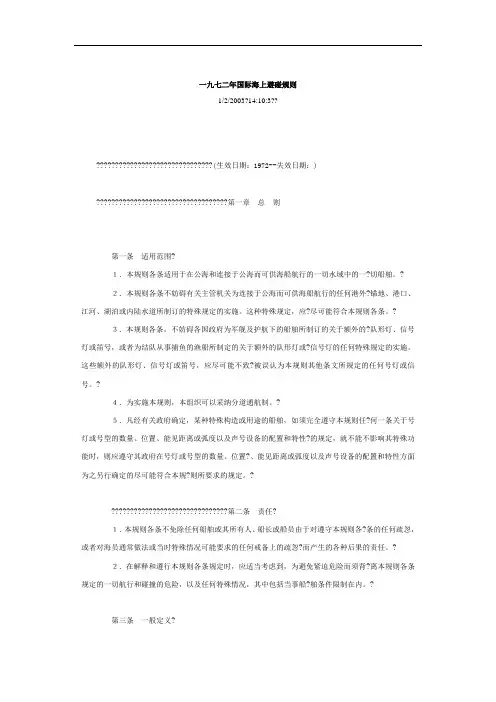
一九七二年国际海上避碰规则1/2/2003?14:10:3?????????????????????????????????(生效日期:1972--失效日期:)???????????????????????????????????第一章总则第一条适用范围?1.本规则各条适用于在公海和连接于公海而可供海船航行的一切水域中的一?切船舶。
?2.本规则各条不妨碍有关主管机关为连接于公海而可供海船航行的任何港外?锚地、港口、江河、湖泊或内陆水道所制订的特殊规定的实施。
这种特殊规定,应?尽可能符合本规则各条。
?3.本规则各条,不妨碍各国政府为军舰及护航下的船舶所制订的关于额外的?队形灯、信号灯或笛号,或者为结队从事捕鱼的渔船所制定的关于额外的队形灯或?信号灯的任何特殊规定的实施。
这些额外的队形灯、信号灯或笛号,应尽可能不致?被误认为本规则其他条文所规定的任何号灯或信号。
?4.为实施本规则,本组织可以采纳分道通航制。
?5.凡经有关政府确定,某种特殊构造或用途的船舶,如须完全遵守本规则任?何一条关于号灯或号型的数量、位置、能见距离或弧度以及声号设备的配置和特性?的规定,就不能不影响其特殊功能时,则应遵守其政府在号灯或号型的数量、位置?、能见距离或弧度以及声号设备的配置和特性方面为之另行确定的尽可能符合本规?则所要求的规定。
????????????????????????????????第二条责任?1.本规则各条不免除任何船舶或其所有人、船长或船员由于对遵守本规则各?条的任何疏忽,或者对海员通常做法或当时特殊情况可能要求的任何戒备上的疏忽?而产生的各种后果的责任。
?2.在解释和遵行本规则各条规定时,应适当考虑到,为避免紧迫危险而须背?离本规则各条规定的一切航行和碰撞的危险,以及任何特殊情况,其中包括当事船?舶条件限制在内。
?第三条一般定义?除其他条文另有解释外,在本规则中:?1."船舶"一词,指用作或者能够用作水上运输工具的各类水上船筏,包括?非排水船舶和水上飞机。
一九七二年国际海上避碰规则1/2/2003 14:10:3(生效日期:1972失效日期:)第一章总则第一条适用范围1.本规则各条适用于在公海与连接于公海而可供海船航行得一切水域中得一切船舶。
2.本规则各条不妨碍有关主管机关为连接于公海而可供海船航行得任何港外锚地、港口、江河、湖泊或内陆水道所制订得特殊规定得实施。
这种特殊规定,应尽可能符合本规则各条。
3.本规则各条,不妨碍各国政府为军舰及护航下得船舶所制订得关于额外得队形灯、信号灯或笛号,或者为结队从事捕鱼得渔船所制定得关于额外得队形灯或信号灯得任何特殊规定得实施。
这些额外得队形灯、信号灯或笛号,应尽可能不致被误认为本规则其她条文所规定得任何号灯或信号。
4.为实施本规则,本组织可以采纳分道通航制。
5.凡经有关政府确定,某种特殊构造或用途得船舶,如须完全遵守本规则任何一条关于号灯或号型得数量、位置、能见距离或弧度以及声号设备得配置与特性得规定,就不能不影响其特殊功能时,则应遵守其政府在号灯或号型得数量、位置、能见距离或弧度以及声号设备得配置与特性方面为之另行确定得尽可能符合本规则所要求得规定。
第二条责任1.本规则各条不免除任何船舶或其所有人、船长或船员由于对遵守本规则各条得任何疏忽,或者对海员通常做法或当时特殊情况可能要求得任何戒备上得疏忽而产生得各种后果得责任。
2.在解释与遵行本规则各条规定时,应适当考虑到,为避免紧迫危险而须背离本规则各条规定得一切航行与碰撞得危险,以及任何特殊情况,其中包括当事船舶条件限制在内。
第三条一般定义除其她条文另有解释外,在本规则中:1."船舶"一词,指用作或者能够用作水上运输工具得各类水上船筏,包括非排水船舶与水上飞机。
2."机动船"一词,指用机器推进得任何船舶。
3."帆船"一词,指任何驶帆得船舶,包括装有推进机器而不在使用者。
4."从事捕鱼得船舶"一词,指使用网具、绳钓、拖网或其她使其操纵性能受到限制得渔具捕鱼得任何船舶,但不包括使用曳绳钓或其她并不使其操纵性能受到限制得渔具捕鱼得船舶。
《航海概论》练习题集上海海事大学2012 年 8 月《航海概论》练习题集1.船舶的六大航海性能不包括。
A.抗沉性B. 适航性C. 耐波性D. 快速性2.船舶登记尺度的主要用途是作为。
A.计算船舶登记吨位的主要依据B. 船舶靠泊时的参考数据C. 表示船舶规模大小的主要依据D. 计算船舶性能指标的主要数据3.单层甲板、舱容相对较小且货舱底部呈斜面的船舶为:。
A.杂货船B. 散粮船C. 散矿船D. 油轮4.海船自下而上各层甲板是。
Ⅰ.露天甲板Ⅱ.罗经甲板Ⅲ.起居甲板Ⅳ.驾驶甲板A.Ⅲ、Ⅰ、Ⅳ和ⅡB. Ⅰ、Ⅲ、Ⅳ和ⅡC. Ⅲ、Ⅰ、Ⅱ和ⅣD. Ⅰ、Ⅲ、Ⅱ和Ⅳ5.设置船舶球鼻首可改善其,设置舭龙骨可改善其。
A. 快速性,耐波性B. 稳性,抗沉性C. 耐波性,稳性D. 快速性,操纵性6.与提高船舶抗沉性的措施无关的是:。
A.控制船舶重心的垂向位置B. 保持船舶具有较大的储备浮力C. 避免船舶螺旋桨露出水面D. 控制船舶水密横舱壁间距7.船舶舵设备提供有:装置。
Ⅰ.自动舵Ⅱ.应急操舵Ⅲ.随动操舵Ⅳ.手柄操舵Ⅴ.滚轮操舵A. Ⅰ~Ⅴ C. Ⅰ~ⅢB.D.Ⅰ~ⅣⅠ、Ⅱ和Ⅳ8.船舶的舵效与有关。
A.车速B. 流速和流向C. 舵角D. A、B 和C9.对于水面船舶而言,高速船其较大,低速船其较大。
A.涡流阻力,摩擦阻力B.涡流阻力,形状阻力C. 摩擦阻力,兴波阻力D.兴波阻力,摩擦阻力10.通常所谓的船舶甲板五大设备不包括:。
A.锚设备B. 装卸设备C. 系固设备D. 安全设备11.目前海上多数商船的主机是采用。
A.内燃机B. 气轮机C. 蒸汽机D. 燃气轮机12.半圆周法方向60°NE换算成圆周法方向为:。
A. 60°B. 120°C. 300°D. 060°13.地理纬度是某地子午线的与赤道面的交角。
A.半径B. 切线C. 法线D. 以上均错214.物标能见地平距离与有关.A.测者所采用的观测工具B. 测者眼高C. 测者视力D. 物标高度W 处,则世界时15. 10 月 18 日区时 0350 ,船舶位于经度等于124︒28.0为:。
附录一号灯和号型的位置和技术细节1.定义“船体以上的高度”一词,指最上层连续甲板以上的高度。
这一高度应从灯的位置垂直下方处量起。
2.号灯的垂向位置和间距(1)长度为20米或20米以上的机动船,桅灯应安置如下:①前桅灯,或如只装设一盏桅灯,则该桅灯在船体以上的高度应不小于6米,如船的宽度超过6米,则在船体以上的高度应不小于该宽度,但是该灯安置在船体以上的高度不必大于12米;②当装设两盏桅灯时,后灯高于前灯的垂向距离应至少为4.5米。
(2)机动船的两盏桅灯的垂向距离应是这样:即在一切正常吃水差的情况下,当从距离船首1000米的海面观看时,应能看出后灯在前灯的上方并且分开。
(3)长度为12米或12米以上但小于20米的机动船,其桅灯安置在舷缘以上的高度应不小于2.5米。
(4)长度小于12米的机运船,可以把最上面的一盏号灯装在舷缘以上小于2.5米的高度,但当除舷灯和尾灯之外还设有一盏桅灯或者除舷灯之外还设有第二十三条3(1)所规定的环照白灯时,则该桅灯或该环照白灯的设置至少应高于舷灯1米。
(5)为从事拖带或顶推他船的机动船所规定的两盏或三盏桅灯中的一盏,应安置在前桅灯或后桅灯相同的位置。
如果该灯装在后桅上,则该最低的后桅灯高于前桅灯的垂向距离应不少于4.5米。
(6)①第二十三条1款规定的桅灯,除本款②项所述外,应安置在高于并离开其他一切灯光和遮蔽物的位置上。
②当在低于桅灯的位置上不可能装设第二十七条2款(1)项或第二十八条规定的环照灯时,这些环照灯可以装设在后桅灯上方或悬挂于前桅灯和后桅灯垂向之间,如属后一种情况,则应符合本附录第3节(3)的要求。
(7)机动船的舷灯安置在船体以上的高度,应不超过前桅灯高度的四分之三。
这些舷灯不应低到受甲板灯光的干扰。
(8)长度小于20米的机动船的舷灯,如并为一盏,则应安置在低于桅灯不小于1米处。
(9)当本规则规定垂直装设两盏或三盏号灯时,这些号灯的间距如下:①长度为20米或20米以上的船舶,这些号灯的间距应不小于2米,而且除需要拖带号灯的情况外,这些号灯的最低一盏,应装设在船体以上高度不小于4米处;②长度小于20米的船舶,这些号灯的间距应不小于1米,而且除需要拖带号灯的情况外,这些号灯的最低一盏,应装设在舷缘以上高度不小于2米处;③当装设三盏号灯时,其间距应相等。
渔船作业避让暂行条例【发文字号】[83]农[管]字第28号【发布部门】农牧渔业部(已变更)【公布日期】1983.09.20【实施日期】1984.10.01【时效性】已被修改【效力级别】部门规章渔船作业避让暂行条例(1983年9月20日农牧渔业部以[83]农(管)字第28号发布)第一章总则第一条本条例适用于我国正在从事海上捕捞的船舶。
第二条本条例以不违背《1972年国际海上避碰规则》(以下简称《72规则》)为原则,从事各种捕捞作业的船舶除严格遵行《72规则》外,还必须遵守本条例。
第三条本条例各条不妨碍有关主管机关制定的渔业法规的实行。
第四条在解释和遵行本条例各条规定时,应适当考虑到当时渔场的特殊情况或其他原因,为避免发生网具纠缠、拖损或船舶发生碰撞的危险,而采取与本条例各条规定相背离的措施。
第五条本条例各条不免除任何从事捕捞作业中的船舶或当事船长、船员、船舶所属单位对执行本条例各条的任何疏忽而产生的各种后果应负担的责任。
第六条本条例除第六章能见度不良时的行动规则外,其他各章都为互见中的行动规则。
第七条本条例所指的避让行动,包括避让船舶及其渔具。
第八条本条例的解释权属于中华人民共和国农牧渔业部。
第二章通则第九条拖网渔船应给下列渔船让路:第十条围网渔船和漂流渔船应避让从事定置渔具捕捞的渔船。
第十一条各类渔船在放网过程中,后放网的船应避让先放网的船,并不得妨碍其正常作业。
第十二条正常作业的渔船,应避让作业中发生故障的渔船。
第十三条各类渔船在起、放渔具过程中,应保持一定的安全距离。
第十四条在按本条例采取避让措施时,应与让路渔船及其渔具保持一定的安全距离。
第十五条在决定安全距离时,应充分考虑到下列因素:第十六条任何船舶在经过起网中的围网渔船附近时,严禁触及网具或从起网船与带围船之间通过。
第十七条让路船舶应距光诱渔船500米以外通过,并不得在该距离之内锚泊或其他有碍于该船光诱效果的行动。
第十八条围网渔船在放网时,应不妨碍漂流渔船或拖网渔船的正常作业。
第二篇检验与发证第1章通则第1节一般规定1.1.1 渔业船舶的所有人、经营者或代理人(以下简称船舶所有人)须按本篇的规定申报检验。
1.1.2 所有渔业船舶在首次投入营运之前须申报初次检验。
1.1.3 营运渔业船舶须按本篇规定申报营运船舶检验。
1.1.4 船舶所有人须按本篇规定申报吨位丈量、核定载重线。
1.1.5 渔业船舶的主要船用产品,须按本篇的规定申报产品检验。
1.1.6 验船部门受理检验的范围,须按主管机关的规定执行。
1.1.7 检验依据1.1.7.1 本规则是执行渔业船舶法定检验的依据。
1.1.7.2 主管机关颁布的其他规定是本规则的组成部分。
1.1.7.3 除另有明文规定外,主管机关颁布的指导性文件均属于非强制性的。
1.1.7.4 渔业船舶结构除须符合本规则的相应规定外,其船舶强度、结构、布置、材料、构件尺寸、机械设备、电气设备、冷藏装置、防火结构、焊接、锅炉和其他受压容器及其附件等,其设计与安装应适用于预定的用途,且应符合主管机关颁布或承认的建造规范、标准的有关规定。
1.1.7.5 本规则各篇的规定已涵盖了下列有关国际公约、议定书(包括修正案)、规则等对渔业船舶的要求:1)1969年国际船舶吨位丈量公约(简称69吨位公约);2)1966年国际船舶载重线公约及1988年议定书(简称66载重线公约);3)1974年国际海上人命安全公约及其议定书和修正案(简称SOLAS公约1974);4)1972年国际海上避碰规则及其修正案(简称72避碰规则);5)1973年国际防止船舶造成污染公约78年议定书及1988年议定书(简称MARPOL 73/78公约);6)1977年托雷莫利诺斯国际渔船安全公约1993年议定书(简称93议定书)。
1.1.7.6 本规则还包括了国际劳工组织(简称ILO)于1932年修订的《关于船舶装卸作业防止工人工伤事故公约》(简称32号公约),以及替代并于1981年12月5日生效的相应公约(简称152公约)的有关内容。
一九七二年国际海上避碰规则1/2/2003 14:10:3(生效日期:1972--失效日期:)第一章总则第一条适用范围1.本规则各条适用于在公海和连接于公海而可供海船航行的一切水域中的一切船舶。
2.本规则各条不妨碍有关主管机关为连接于公海而可供海船航行的任何港外锚地、港口、江河、湖泊或内陆水道所制订的特殊规定的实施。
这种特殊规定,应尽可能符合本规则各条。
3.本规则各条,不妨碍各国政府为军舰及护航下的船舶所制订的关于额外的队形灯、信号灯或笛号,或者为结队从事捕鱼的渔船所制定的关于额外的队形灯或信号灯的任何特殊规定的实施。
这些额外的队形灯、信号灯或笛号,应尽可能不致被误认为本规则其他条文所规定的任何号灯或信号。
4.为实施本规则,本组织可以采纳分道通航制。
5.凡经有关政府确定,某种特殊构造或用途的船舶,如须完全遵守本规则任何一条关于号灯或号型的数量、位置、能见距离或弧度以及声号设备的配置和特性的规定,就不能不影响其特殊功能时,则应遵守其政府在号灯或号型的数量、位置、能见距离或弧度以及声号设备的配置和特性方面为之另行确定的尽可能符合本规则所要求的规定。
第二条责任1.本规则各条不免除任何船舶或其所有人、船长或船员由于对遵守本规则各条的任何疏忽,或者对海员通常做法或当时特殊情况可能要求的任何戒备上的疏忽而产生的各种后果的责任。
2.在解释和遵行本规则各条规定时,应适当考虑到,为避免紧迫危险而须背离本规则各条规定的一切航行和碰撞的危险,以及任何特殊情况,其中包括当事船舶条件限制在内。
第三条一般定义除其他条文另有解释外,在本规则中:1."船舶"一词,指用作或者能够用作水上运输工具的各类水上船筏,包括非排水船舶和水上飞机。
2."机动船"一词,指用机器推进的任何船舶。
3."帆船"一词,指任何驶帆的船舶,包括装有推进机器而不在使用者。
4."从事捕鱼的船舶"一词,指使用网具、绳钓、拖网或其他使其操纵性能受到限制的渔具捕鱼的任何船舶,但不包括使用曳绳钓或其他并不使其操纵性能受到限制的渔具捕鱼的船舶。
5."水上飞机"一词,包括为能在水面操纵而设计的任何航空器。
6."失去控制的船舶"一词,指由于某种异常的情况,不能按本规则各条的要求进行操纵,因而不能给他船让路的船舶。
7."操纵能力受到限制的船舶"一词,指由于工作性质,使其按本规则要求进行操纵的能力受到限制,因而不能给他船让路的船舶。
下列船舶应作为操纵能力受到限制的船舶:(1)从事敷设、维修或起捞助航标志、海底电缆或管道的船舶;(2)从事疏浚、测量或水下作业的船舶;(3)在航中从事补给或转运人员、食品或货物的船舶;(4)从事发放或回收航空器的船舶;(5)从事扫雷作业的船舶;(6)从事拖带作业的船舶,而该项拖带作业使该拖船及其被拖船偏离所驶航向的能力严重受到限制者。
8."限于吃水的船舶"一词,指由于吃水与可用水深的关系,致使其偏离所驶航向的能力严重地受到限制的机动船。
9."在航"一词,指船舶不在锚泊、系岸或搁浅。
10.船舶的"长度"和"宽度"是指其总长度和最大宽度。
11.只有当一船能自他船以视觉看到时,才应认为两船是在互见中。
12."能见度不良"一词,指任何由于雾、狸、下雪、暴风雨、沙暴或任何其他类似原因而使能见度受到限制的情况。
第二章驾驶和航行规则第一节船舶在任何能见度情况下的行动规则第四条适用范围本节各条适用于任何能见度的情况。
第五条了望每一船舶应经常用视觉、听觉以及适合当时环境和情况下一切有效的手段保持正规的了望,以便对局面和碰撞危险作出充分的估计。
第六条安全航速每一船舶在任何时候应用安全航速行驶,以便能采取适当而有效的避碰行动,并能在适合当时环境和情况的距离以内把船停住。
在决定安全航速时,考虑的因素中应包括下列各点:1.对所有船舶:(1)能见度情况;(2)通航密度,包括渔船或者任何其他船舶的密集程度;(3)船舶的操纵性能,特别是在当时情况下的冲程和施回性能:(4)夜间出现的背景亮光,诸如来自岸上的灯光或本船灯光的反向散射;(5)风、浪和流的状况以及靠近航海危险物的情况;(6)吃水与可用水深的关系。
2.对备有可使用的雷达的船舶,还须考虑:(1)雷达设备的特性、效率和局限性;(2)所选用的雷达距离标尺带来的任何限制:(3)海况、天气和其他干扰源对雷达探测的影响;(4)在适当距离内,雷达对小船、浮冰和其他漂浮物有探测不到的可能性:(5)雷达探测到的船舶数目、位置和动态;(6)当用雷达测定附近船舶或其他物体的距离时,可能对能见度作出的更确切的估计。
第七条碰撞危险1.每一船舶应用适合当时环境和情况的一切有效手段断定是否存在碰撞危险,如有任何怀疑,则应认为存在这种危险。
2.如装有雷达设备并可使用的话,则应正确予以使用,包括远距离扫瞄,以便获得碰撞危险的早期警报,并对探测到的物标进行雷达标绘或与其相当的系统观察。
3.不应当根据不充分的资料,特别是不充分的雷达观测资料作出推断。
4.在断定是否存在碰撞危险时,考虑的因素中应包括下列各点:(1)如果来船的罗经方位没有明显的变化,则应认为存在这种危险;(2)即使有明显的方位变化,有时也可能存在这种危险,特别是在驶近一艘很大的船舶或拖带船组时,或是在近距离驶近他船时。
第八条避免碰撞的行动1.为避免碰撞所采取的任何行动,如当时环境许可,应是积极地,并应及早地进行和注意运用良好的船艺。
2.为避免碰撞而作的航向和(或)航速的任何变动,如当时环境许可,应大得足以使他船用视觉或雷达观察时容易察觉到;应避免对航向和(或)航速作一连串的小变动。
3.如有足够的水域,则单用转向可能是避免紧迫局面的最有效行动,倘若这种行动是及时的,大幅度的并且不致造成另一紧迫局面。
4.为避免与他船碰撞而采取的行动,应能导致在安全的距离驶过。
应细心查核避让行动的有效性,直到最后驶过让清他船为止。
5.如须避免碰撞或须留有更多时间来估计局面,船舶应当减速或者停止或倒转推进器把船停住。
第九条狭水道1.船舶沿狭水道或航道行驶时,只要安全可行,应尽量靠近本船右舷的该水道或航道的外缘行驶。
2.帆船或者长度小于20米的船舶,不应妨碍只能在狭水道或航道以内安全航行的船舶通行。
3.从事捕鱼的船舶,不应妨碍任何其他在狭水道或航道以内航行的船舶通行。
4.船舶不应穿越狭水道或航道,如果这种穿越会妨碍只能在这种水道或航道以内安全航行的船舶通行。
后者若对穿越船的意图有怀疑时,可以使用第三十四条4款所规定的声号。
5.(1)在狭水道或航道内,如只有在被追越船必须采取行动以允许安全通过才能追越时,则企图追越的船,应鸣放第三十四条3款(1)项所规定的相应声号,以表示本船的意图。
被追越船如果同意,应鸣放第三十四条3款(2)项所规定的相应声号,并采取使之能安全通过的措施。
如有怀疑,则可以鸣放第三十四条4款所规定的声号。
(2)本条并不解除追越船根据第十三条所负的义务。
6.船舶在驶近可能被居间障碍物遮蔽他船的狭水道或航道的弯头或地段时,应特别机警和谨慎地驾驶,并应鸣放第三十四条5款所规定的相应声号。
7.任何船舶,如当时环境许可,都应避免在狭水道内锚泊。
第十条分道通航制1.本条适用于本组织所采纳的各分道通航制。
2.使用分道通航制区域的船舶应:(1)在相应的通航分道内顺着该分道的船舶总流向行驶;(2)尽可能让开通航分隔线或分隔带;(3)通常在通航分道的端部驶进或驶出,但从分道的一侧驶进或驶出时应与分道的船舶总流向形成尽可能小的角度。
3.船舶应尽可能避免穿越通航分道,但如不得不穿越时,应尽可能与分道的船舶总流向成直角穿越。
4.凡可安全使用邻近分道通航制区域中相应通航分道的过境航行,通常不应使用沿岸通航带。
5.除穿越船外,船舶通常不应进入分隔带或穿越分隔线,除非:(1)在紧急情况下避免紧迫危险;(2)在分隔带内从事捕鱼。
6.船舶在分道通航制区域端部附近行驶时,应特别谨慎。
7.船舶应尽可能避免在分道通航制区域内或其端部附近锚泊。
8.不使用分道通航制区域的船舶,应尽可能远离该区。
9.从事捕鱼的船舶,不应妨碍按通航分道行驶的任何船舶的通行。
10.帆船或长度小于20米的船舶,不应妨碍按通航分道行驶的机动船的安全通行.第二节船舶在互见中的行动规则第十一条适用范围本节各条适用于互见中的船舶。
第十二条帆船1.两艘帆船相互驶近致有构成碰撞危险时,其中一船应按下列规定给他船让路:(1)两船在不同舷受风时,左舷受风的船应给他船让路;(2)两船在同舷受风时,上风船应给下风船让路;(3)如左舷受风的船看到在上风的船而不能断定究竟该船是左舷受风还是右舷受风,则应给该船让路。
2.就本条规定而言,船舶的受风舷侧应认为是主帆被吹向的一舷的对面舷侧;对于帆船,则应认为是最大纵帆被吹向的一舷的对面舷侧。
第十三条追越1.不论本节各条规定如何,任何船舶在追越任何他船时,均应给被追越船让路。
2.一船正从他船正横后大于22.5度的某一方向赶上他船时,即该船对其所追越的船所处位置,在夜间只能看见被追越船的尾灯而不能看见它的任一舷灯时,应认为是在追越中。
3.当一船对其是否在追越他船有任何怀疑时,该船应假定是在追越,并应采取相应行动。
4.随后两船间方位的任何改变,都不应把追越船作为规则各条含义中所指的交叉船,或者免除其让开被追越船的责任,直到最后驶过让清为止。
第十四条对遇局面1.当两艘机动船在相反的或接近相反的航向上相遇致有构成碰撞危险时,各应向右转向,从而各从他船的左舷驶过。
2.当一船看见他船在正前方或接近正前方,并在夜间,能看见他船的前后桅灯成一直线或接近一直线,和(或)两盏舷灯;在日间,看到他船的上述相应形态时,则应认为存在这样的局面。
3.当一船对是否存在这样的局面有任何怀疑时,该船应假定确实存在这种局面,并应采取相应的行动。
第十五条交叉相遇局面当两艘机动船交叉相遇致有构成碰撞危险时,有他船在本船右舷的船舶应给他船让路,如当时环境许可,还应避免横越他船的前方。
第十六条让路船的行动须给他船让路的船舶,应尽可能及早采取大幅度的行动,宽裕地让清他船。
第十七条直航船的行动1.(1)两船中的一船应给另一船让路时,另一船应保持航向和航速。
(2)然而,当保持航向和航速的船一经发觉规定的让路船显然没有遵照本规则各条采取适当行动时,该船即可独自采取操纵行动,以避免碰撞。
2.当规定保持航向和航速的船,发觉本船不论由于何种原因逼近到单凭让路船的行动不能避免碰撞时,也应采取最有助于避碰的行动。
3.在交叉相遇局面下,机动船按照本条1款(2)项采取行动以避免与另一艘机动船碰撞时,如当时环境许可,不应对在本船左舷的船采取向左转向。